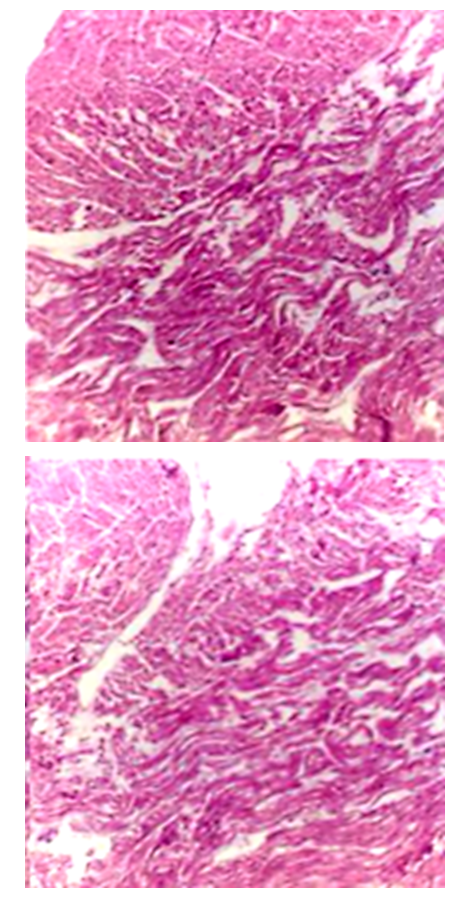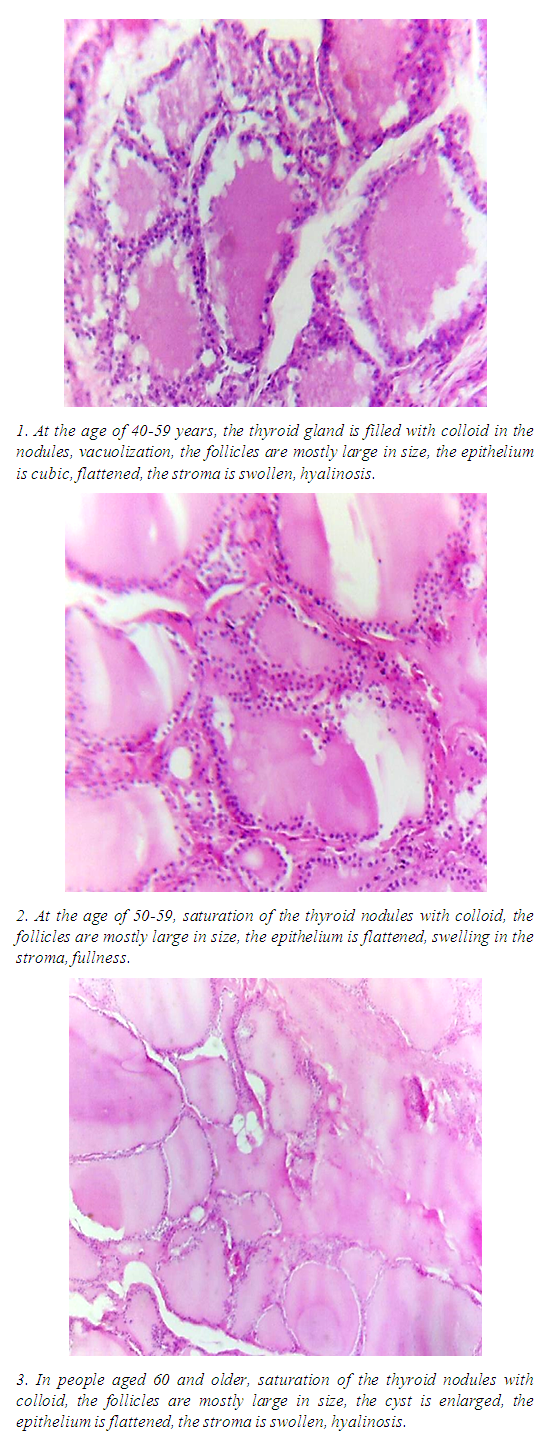-
Paper Information
- Next Paper
- Previous Paper
- Paper Submission
-
Journal Information
- About This Journal
- Editorial Board
- Current Issue
- Archive
- Author Guidelines
- Contact Us
American Journal of Medicine and Medical Sciences
p-ISSN: 2165-901X e-ISSN: 2165-9036
2024; 14(6): 1522-1524
doi:10.5923/j.ajmms.20241406.10
Received: Mar. 8, 2024; Accepted: Apr. 6, 2024; Published: Jun. 13, 2024

Pathomorphological Changes in Myocardial Contractile Injuries and Thyroid Gland Dysfunctions in Sudden Cardiac Death
Z. Q. Khakimov, A. R. Mamataliyev, M. A. Mamatalieva, Kh. M. Imomov
Pathological Anatomy and Forensic Medicine, Andijan State Medical Institute, Andijan, Uzbekistan
Correspondence to: Z. Q. Khakimov, Pathological Anatomy and Forensic Medicine, Andijan State Medical Institute, Andijan, Uzbekistan.
| Email: |  |
Copyright © 2024 The Author(s). Published by Scientific & Academic Publishing.
This work is licensed under the Creative Commons Attribution International License (CC BY).
http://creativecommons.org/licenses/by/4.0/

Dysfunctional changes in the thyroid gland during sudden cardiac death were studied. Cardiac arrest in sudden cardiac death has been investigated for direct association with ventricular fibrillation and their asystole, which occur under conditions of unstable electrical conduction of the heart, with specific morphological and morphometric changes occurring in the thyroid gland in parallel with changes in the heart of people who died of sudden cardiac death.
Keywords: Sudden cardiac death (SCD), Thyroid gland, Morphometry
Cite this paper: Z. Q. Khakimov, A. R. Mamataliyev, M. A. Mamatalieva, Kh. M. Imomov, Pathomorphological Changes in Myocardial Contractile Injuries and Thyroid Gland Dysfunctions in Sudden Cardiac Death, American Journal of Medicine and Medical Sciences, Vol. 14 No. 6, 2024, pp. 1522-1524. doi: 10.5923/j.ajmms.20241406.10.
Article Outline
1. Annotation
- Contractile lesions of the heart and dysfunctional changes in the thyroid gland during sudden cardiac death were studied in 40 men aged 20-70 years. In case of sudden cardiac death, grade 2-3 contracture injuries predominated in cardiomyocytes in all parts of the myocardium, and changes in the thyroid gland were noted as a compensatory-adaptive reaction. The manifestation of morphological signs of secretory and resorptive activity of the thyroid gland during sudden cardiac death corresponded to contracture damage to the myocardium.
2. Relevance
- Cardiac arrest in sudden cardiac deaths is directly related to ventricular fibrillation and their asystole, which appear in conditions of unstable electrical conduction of the heart [1]. The functional state of the thyroid gland is of great importance in the course of ischemic heart diseases, sudden deaths and sudden cardiac deaths, and in a number of studies, diabetes, hypertension as an independent and important risk factor in the development of acute forms of ischemic heart diseases Manifest and subclinical hypothyroidism have been reported as important as smoking and obesity [2,3,4,5].In parallel with the changes in the heart of people who died of sudden cardiac death, living in the endemic region under the influence of biogeochemical environmental factors for a long time, specific morphological and morphometric changes occur in the thyroid gland.
3. Research Materials and Methods
- Contracture lesions in the heart and dysfunctional changes in the thyroid gland in sudden cardiac deaths were studied in 40 men aged 20-70 years. Morphological changes and morphometric indicators of the heart and thyroid gland of 40 people of this age who died suddenly due to other causes (injury of large blood vessels, internal bleeding) were given to them as a control group. In the study of these materials, forensic medical histology materials were used. Morphological, morphometric, statistical research methods were used in the study [6]. Acute manifestations of sudden cardiac death were observed with diffuse ischemic injury of the myocardium in the form of hyperrelaxation of cardiomyositis, contracture degeneration of cardiomyositis, intracellular myostolysis and disintegration.In sudden cardiac deaths, the resorption of the hormonal components of the structure of the thyroid follicles is observed, which is manifested by the activation of the function of thyrocysts (an increase in the height of the thyroid epithelium, the formation of new follicles with an increase in the number of microfollicles with liquid colloid, a sharp reaction of the microcirculatory vessels) These indicators were reliably different when compared to the control group.Morphological signs of sudden cardiac death include the combination of two processes in the field of myocardial ischemia - contracture injuries and ischemia, reperfusion with hyperrelaxation of sarcomeres, and they were determined using polarization microscopy. In polarization microscopy, contracture injuries were distinguished by the degree of injury - 1 and 2 - degrees I were characterized by the convergence of A-discs (anisotropics) due to the thinning of I-discs (isotopes); Grade 3 contracture was characterized by complete loss of I-discs, fusion of A-discs into a single conglomerate, and bright light areas. Myocardial dissection was characterized by the presence of many eroded structures in an anisotropic substance.
4. Research Results
- Heart morphometric parameters in the research group: heart weight - 330±3.3g, length 10.1±0.2cm, width 9.4±0.3cm, thickness 5.2±0.4cm, left ventricular wall thickness - 1.6±0.1 cm, the thickness of the walls of the right ventricle - 0.6±0.1 cm. When these indicators were compared, they were higher in sudden cardiac death compared to the control group. When both ventricles were histologically examined, a predominance of 2-3 degree contracture damage of cardiomyositis was observed (Pic. 1). The amount of contractures in the left ventricle was 53.4 ±2.0%. The location of contractures was most often found in the anterior, lateral and posterior walls of the left ventricle, mainly in the subendocardial and intramural sections of the myocardium.
 | Picture 1. Contracture injury of cardiomyositis of the 2nd-3rd degree in sudden cardiac death. Hem.-eosin staining. 4x12.5 magnification |
 | Picture 2. Hem.-eosin was stained, magnification 10x12.5 |
5. Summary
- In sudden cardiac deaths, cardiomyositis of the 2nd-3rd degree of contracture damage was observed in all areas of the myocardium, changes in the thyroid gland were noted as a compensatory adaptive reaction. Manifestation of morphological signs of the secretory and resorptive activity of the thyroid gland in sudden cardiac deaths paralleled the contracture damage of the myocardium. Morphological reconstruction of the follicular apparatus and capillary network of the thyroid gland reflected the changes in the functional state of the thyroid gland in sudden cardiac deaths.
 Abstract
Abstract Reference
Reference Full-Text PDF
Full-Text PDF Full-text HTML
Full-text HTML